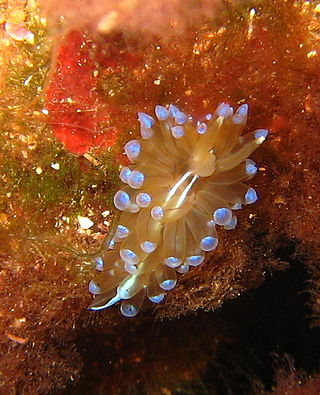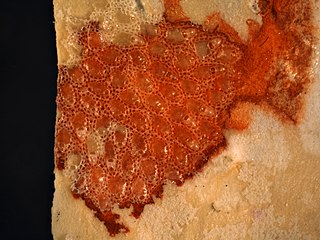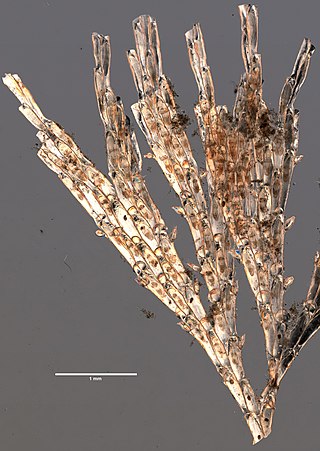
Bryozoa are a phylum of simple, aquatic invertebrate animals, nearly all living in sedentary colonies. Typically about 0.5 millimetres long, they have a special feeding structure called a lophophore, a "crown" of tentacles used for filter feeding. Most marine bryozoans live in tropical waters, but a few are found in oceanic trenches and polar waters. The bryozoans are classified as the marine bryozoans (Stenolaemata), freshwater bryozoans (Phylactolaemata), and mostly-marine bryozoans (Gymnolaemata), a few members of which prefer brackish water. 5,869 living species are known. At least two genera are solitary ; the rest are colonial.

Membranipora membranacea is a very widely distributed species of marine bryozoan known from the Atlantic and Pacific Oceans, usually in temperate zone environments. This bryozoan is a colonial organism characterized by a thin, mat-like encrustation, white to gray in color. It may be known colloquially as the coffin box, sea-mat or lacy crust bryozoan and is often abundantly found encrusting seaweeds, particularly kelps.

Flustra foliacea is a species of bryozoans found in the northern Atlantic Ocean. It is a colonial animal that is frequently mistaken for a seaweed. Colonies begin as encrusting mats, and only produce loose fronds after their first year of growth. They may reach 20 cm (8 in) long, and smell like lemons. Its microscopic structure was examined by Robert Hooke and illustrated in his 1665 work Micrographia.
Amathia vidovici is a species of colonial bryozoans with a tree-like structure. It is found in shallow waters over a wide geographical range, being found in both the Atlantic and Pacific Oceans and adjoining seas.
Amathia verticillata, commonly known as the spaghetti bryozoan, is a species of colonial bryozoans with a bush-like structure. It is found in shallow temperate and warm waters in the western Atlantic Ocean and the Caribbean Sea and has spread worldwide as a fouling organism. It is regarded as an invasive species in some countries.

Conopeum seurati is a species of colonial bryozoan in the order Cheilostomatida. It is native to the northeastern Atlantic Ocean, the North Sea and the Mediterranean Sea. This species has been introduced to New Zealand and Florida.

Antiopella cristata, sometimes known by the common name crested aeolis, is a species of nudibranch, a marine gastropod mollusc in the family Janolidae.

Electra pilosa is a species of colonial bryozoan in the order Cheilostomatida. It is native to the northeastern and northwestern Atlantic Ocean and is also present in Australia and New Zealand.

Cryptosula pallasiana is a species of colonial bryozoan in the order Cheilostomatida. It is native to the Atlantic Ocean where it occurs in northwestern Europe and northern Africa, and the eastern seaboard of North America. It has been accidentally introduced to the western coast of North America and to other parts of the world.

Watersipora subtorquata, commonly known as the red-rust bryozoan, is a species of colonial bryozoan in the family Watersiporidae. It is unclear from where it originated but it is now present in many warm-water coastal regions throughout the world, and has become invasive on the west coast of North America and in Australia and New Zealand.

Catenicella is a genus of marine bryozoans belonging to the family Catenicellidae. Bryozoans are colonial animals that live in aquatic environments, and Catenicella is no exception. Members of this genus are found in oceans around the world, with a particularly high diversity in the Arctic and Antarctic regions.

Beania magellanica is a species of colonial bryozoan in the family Beaniidae. It has a cosmopolitan distribution, occurring in shallow waters in the Atlantic and Pacific Oceans and in Antarctica.

Electra posidoniae is a species of bryozoan in the family Electridae. It is endemic to the Mediterranean Sea, and is commonly known as the Neptune-grass bryozoan because it is exclusively found growing on seagrasses, usually on Neptune grass, but occasionally on eelgrass.
Callopora lineata is a species of colonial bryozoan in the family Calloporidae. It is found on rocky shores in the Atlantic Ocean and the Mediterranean Sea.

Chorizopora brongniartii is a species of bryozoan in the family Chorizoporidae. It is an encrusting bryozoan, the colonies forming spreading patches. It has a widespread distribution in tropical and temperate seas.

Crisularia plumosa is a species of bryozoan belonging to the family Bugulidae, commonly known as the feather bryozoan. It is native to the Atlantic Ocean.
Bugulina turbinata is a species of bryozoan belonging to the family Bugulidae. It is found in shallow water in the northeastern Atlantic Ocean and the Mediterranean Sea.

Bugulina flabellata is a species of bryozoan belonging to the family Bugulidae. It is found in shallow water in the northeastern Atlantic Ocean and the Mediterranean Sea.
Walkeria uva is a species of colonial bryozoan in the order Ctenostomatida. It occurs on either side of the Atlantic Ocean, in the Baltic Sea, in the Mediterranean Sea and in the Indo-Pacific region.
Lichenalia is an extinct genus of cystoporate bryozoan belonging to the family Rhinoporidae. It is known from the Upper Ordovician to the Middle Silurian periods, which spanned from approximately 460 to 430 million years ago. The genus had a cosmopolitan distribution, with fossil specimens found in various regions of the world, including North America, Europe, and Asia.













